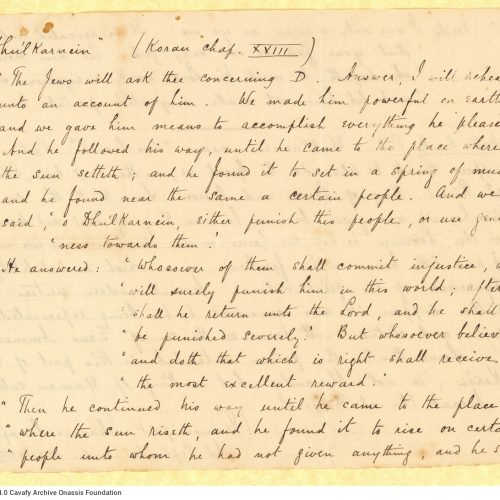υπογράμμιση
υπογράμμιση
πράσινη γραμματοσειρά
κίτρινη γραμματοσειρά
κόκκινη γραμματοσειρά
DIGITAL OBJECT DESCRIPTION
IDENTITY AREA
17 x 20.5 cm
CONTEXT AREA
CONTENT AND STRUCTURE AREA
Handwritten letter by John Cavafy to C. P. Cavafy on three letterheads of R. J. Moss & Co., Alexandria. Sheets 2 and 3 are numbered at top right. Answers to questions of C. P. Cavafy and update on the situation in Alexandria. Handwritten quote from the Quran related to Dhul-Qarnayn, asked for by C. P. Cavafy. Signed and dated in Latin by John.
CONDITIONS OF ACCESS AND USE AREA
English
Writing in ink. Indiscernible watermark. Physical item wear: oxidations.
NOTES AREA
The transcription and editing of the letters of John Constantine Cavafy addressed to C. P. Cavafy was first carried out by Katerina Ghika; said transcriptions were subsequently uploaded to the official website of the Cavafy Archive.
John Cavafy refers to his poem “Rivers of Babylon” and anxiously awaits the critique of C. P. Cavafy.
ACCESS POINTS
Cavafy, John Constantine. “Letter by John Cavafy to C. P. Cavafy”. Letter, 19.09.1882. GR-OF CA CA-SF02-S01-SS02-F20-SF001-0004 (379), Onassis Foundation C. P. Cavafy Fonds. From The Digital Collection of the Cavafy Archive, edited by Onassis Foundation, Athens, last modified 01.10.2025. https://doi.org/10.26256/CA-SF02-S01-SS02-F20-SF001-0004.













